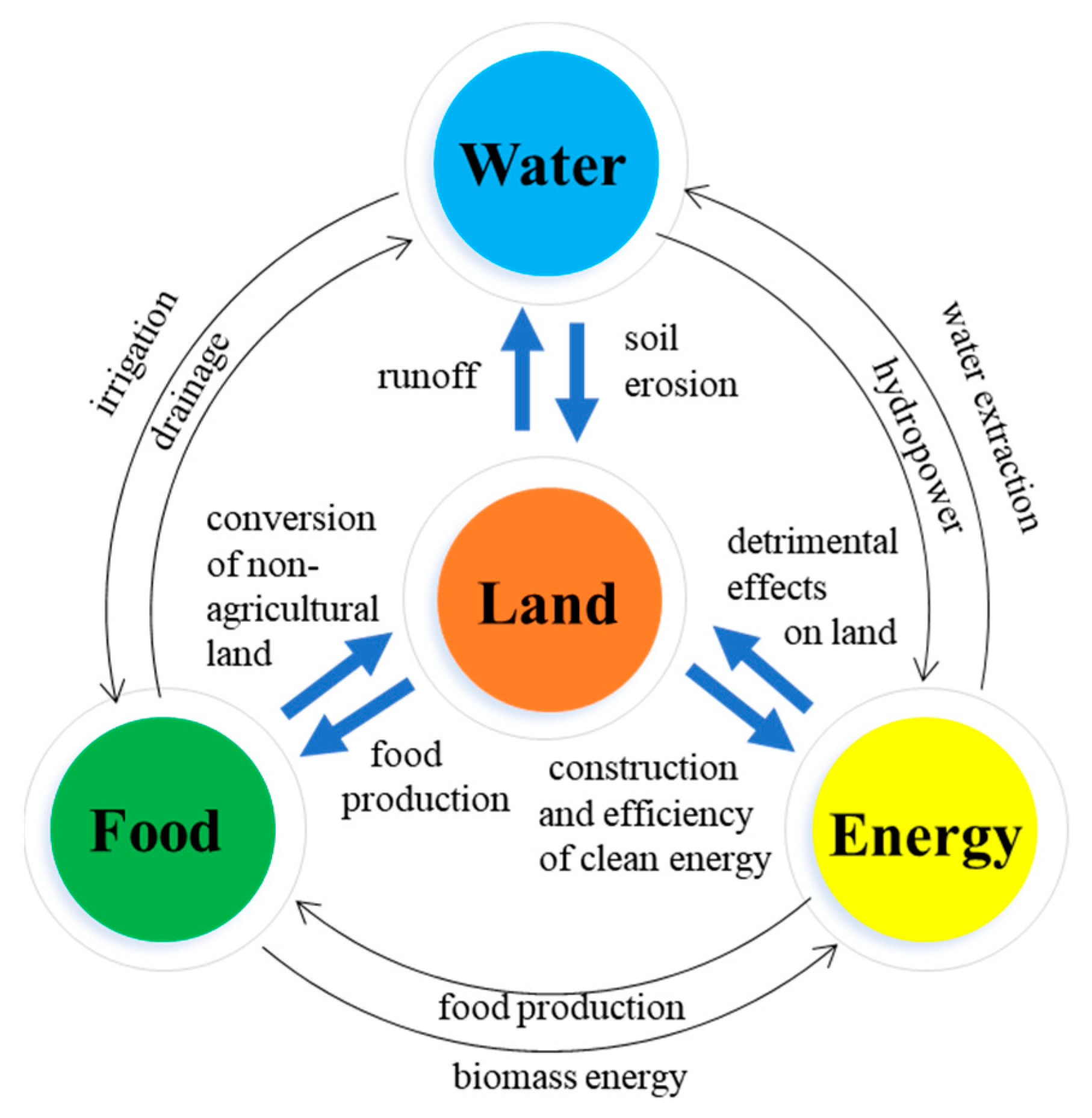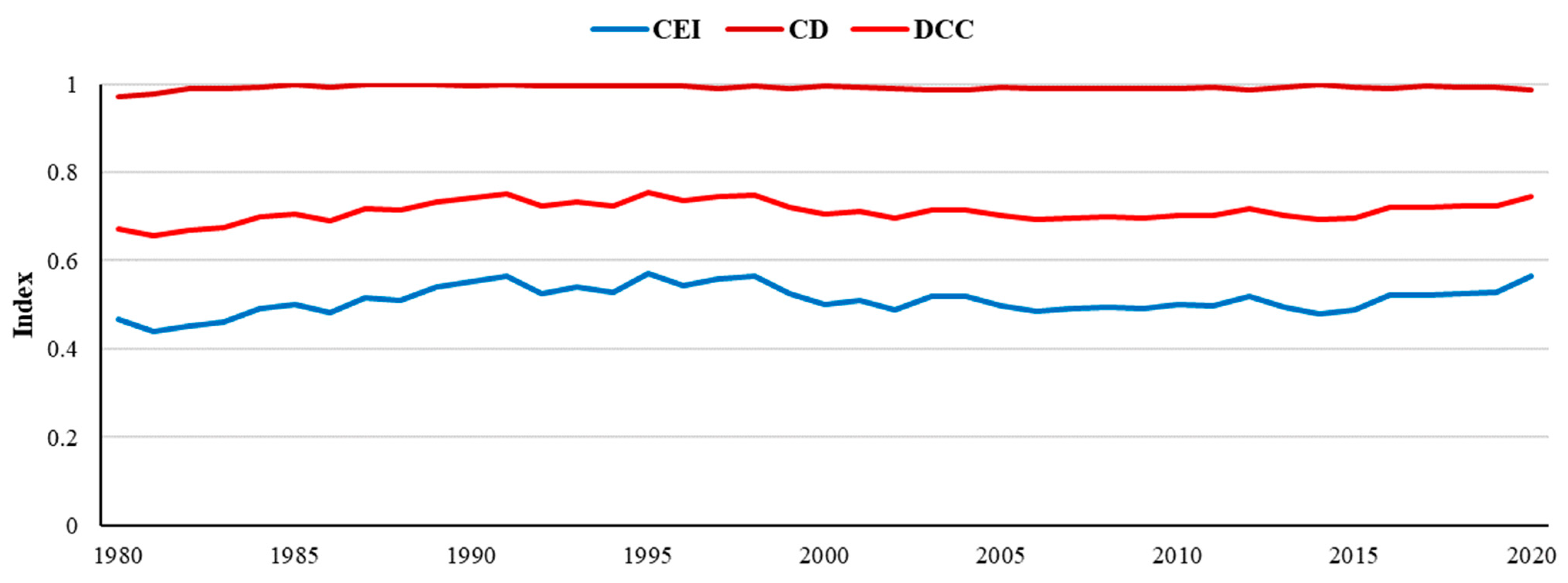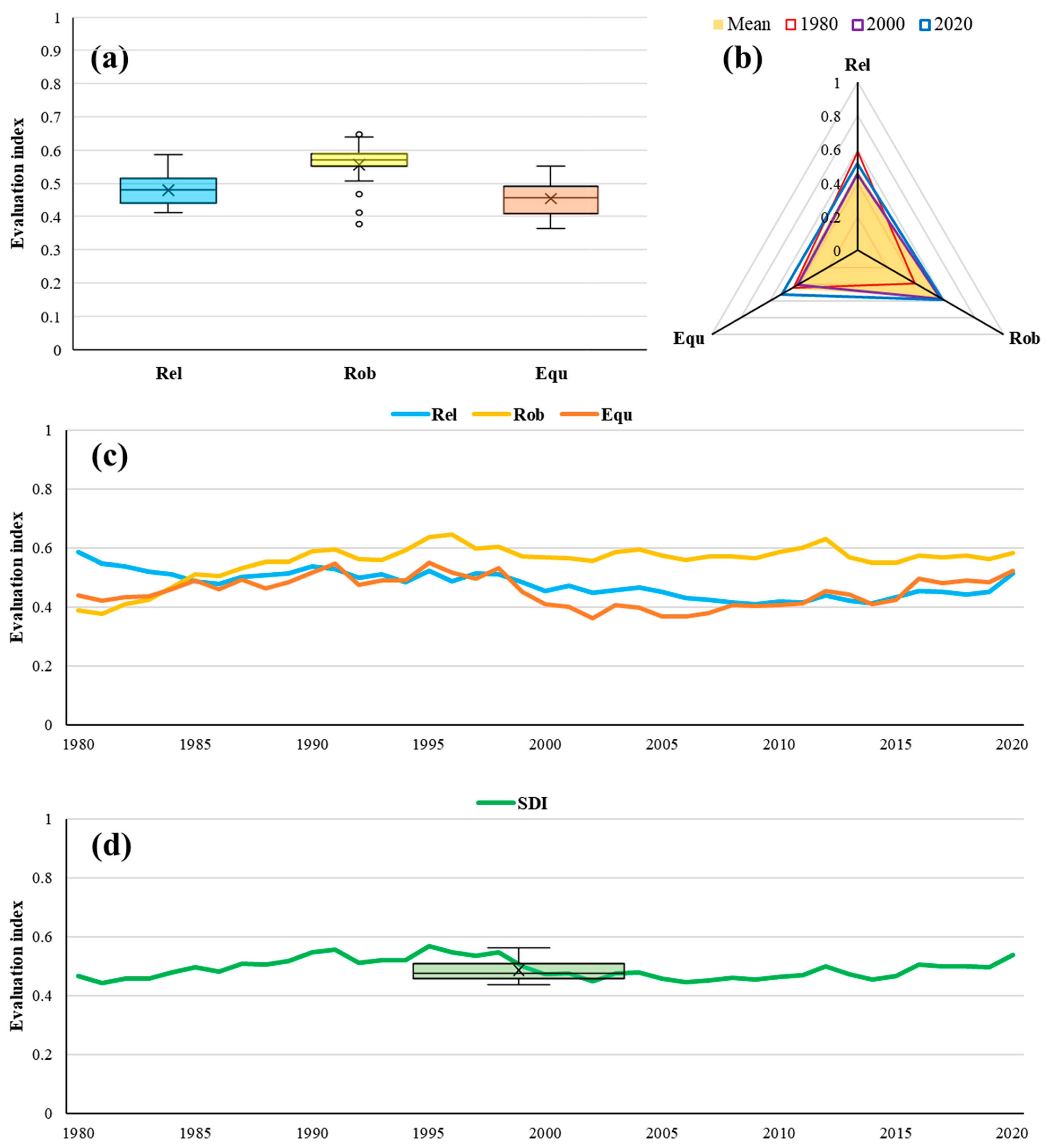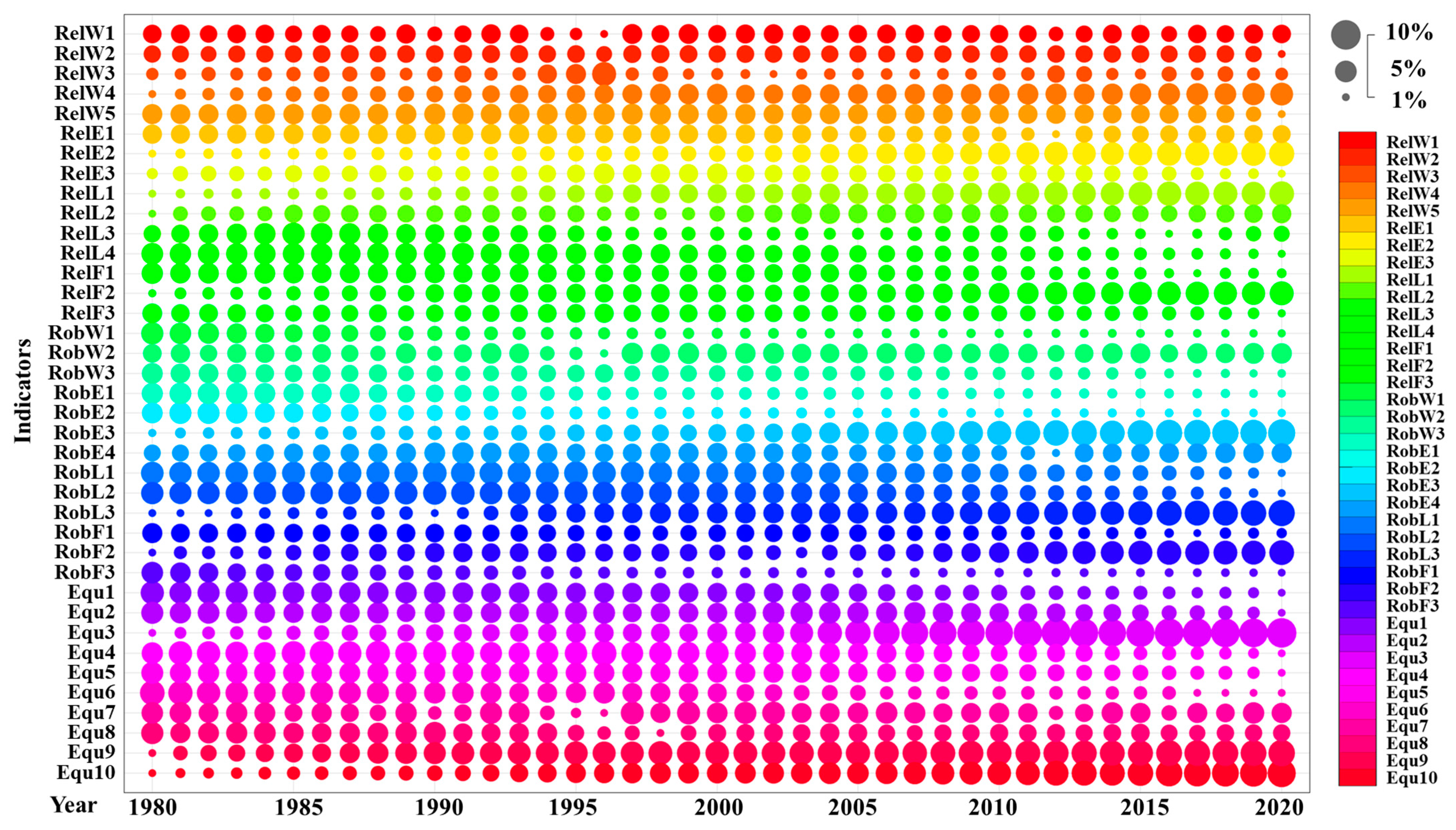Evaluation of the Coupling Coordination and Sustainable Development of Water–Energy–Land–Food System on a 40-Year Scale: A Case Study of Hebei, China
Abstract
:1. Introduction
2. Materials and Methods
2.1. Study Area
2.2. Evaluation Indicators System and Data Sources
2.3. Methodology
2.3.1. Standardization of Indicators
2.3.2. Weight Determination
2.3.3. Comprehensive Evaluation Methodology
2.3.4. Obstacle Degree Model
2.3.5. Gray Relational Degree Model
3. Results
3.1. Temporal Variation Analysis of WELF System
3.2. Temporal Variation Analysis of SDI of WELF System
3.3. Obstacle Degree Analysis
3.4. Gray Correlation Degree Analysis
4. Discussion
4.1. Policy Recommendations
4.2. Development Trend and Policy Impact of Water–Energy–Food System in Different Regions of China
4.3. Limitations and Suggestions
5. Conclusions
Author Contributions
Funding
Data Availability Statement
Acknowledgments
Conflicts of Interest
References
- Silalertruksa, T.; Gheewala, S.H. Land-water-energy nexus of sugarcane production in Thailand. J. Clean. Prod. 2018, 182, 521–528. [Google Scholar] [CrossRef]
- Roxani, A.; Zisos, A.; Sakki, G.-K.; Efstratiadis, A. Multidimensional role of Agrovoltaics in era of EU green Deal: Current status and analysis of water–energy–food–land dependencies. Land 2023, 12, 1069. [Google Scholar] [CrossRef]
- Hanasaki, N.; Fujimori, S.; Yamamoto, T.; Yoshikawa, S.; Masaki, Y.; Hijioka, Y.; Kainuma, M.; Kanamori, Y.; Masui, T.; Takahashi, K.; et al. A global water scarcity assessment under Shared Socio-economic Pathways—Part 1: Water use. Hydrol. Earth Syst. Sci. 2013, 17, 2375–2391. [Google Scholar] [CrossRef]
- Bauer, N.; Calvin, K.; Emmerling, J.; Fricko, O.; Vuuren, D.P.V. Shared Socio-Economic Pathways of the Energy Sector—Quantifying the Narratives. Glob. Environ. Change 2017, 42, 316–330. [Google Scholar] [CrossRef]
- Popp, A.; Calvin, K.; Fujimori, S.; Havlik, P.; Vuuren, D.P.V. Land-use futures in the shared socio-economic pathways. Glob. Environ. Change 2017, 42, 331–345. [Google Scholar] [CrossRef]
- Valin, H.; Sands, R.D.; Mensbrugghe, D.V.D.; Nelson, G.C.; Ahammad, H.; Blanc, E.; Bodirsky, B.; Fujimori, S.; Hasegawa, T.; Havlik, P. The future of food demand: Understanding differences in global economic models. Agric. Econ. 2014, 45, 51–67. [Google Scholar] [CrossRef]
- United Nations (UN). Transforming Our World: The 2030 Agenda for Sustainable Development. 2015. Available online: https://sdgs.un.org/2030agenda (accessed on 20 May 2024).
- Sušnik, J.; Chew, C.; Domingo, X.; Mereu, S.; Trabucco, A.; Evans, B.; Vamvakeridou-Lyroudia, L.; Savić, D.A.; Laspidou, C.; Brouwer, F. Multi-stakeholder development of a serious game to explore the water-energy-food-land-climate nexus: The SIM4NEXUS approach. Water 2018, 10, 139. [Google Scholar] [CrossRef]
- Ringler, C.; Bhaduri, A.; Lawford, R. The nexus across water, energy, land and food (WELF): Potential for improved resource use efficiency? Curr. Opin. Environ. Sustain. 2013, 5, 617–624. [Google Scholar] [CrossRef]
- Yao, X.; Chen, W.; Song, C.; Gao, S. Sustainability and efficiency of water-land-energy-food nexus based on energy-ecological footprint and data envelopment analysis: Case of an important agriculture and ecological region in Northeast China. J. Clean. Prod. 2022, 379, 134854. [Google Scholar] [CrossRef]
- Turner, B.L.; Fuhrer, J.; Wuellner, M.; Menendez, H.M.; Gates, R. Scientific case studies in land-use driven soil erosion in the central United States: Why soil potential and risk concepts should be included in the principles of soil health. Int. Soil Water Conserv. Res. 2018, 6, 63–78. [Google Scholar] [CrossRef]
- Sargentis, G.F.; Siamparina, P.; Sakki, G.K.; Efstratiadis, A.; Koutsoyiannis, D. Agricultural land or photovoltaic parks? The water–energy–food nexus and land development perspectives in the thessaly plain, Greece. Sustainability 2021, 13, 8935. [Google Scholar] [CrossRef]
- Dhar, A.; Naeth, M.A.; Jennings, P.D.; El-Din, M.G. Perspectives on environmental impacts and a land reclamation strategy for solar and wind energy systems. Sci. Total Environ. 2020, 718, 134602. [Google Scholar] [CrossRef]
- Dale, V.H.; Efroymson, R.A.; Kline, K.L. The land use–climate change–energy nexus. Landsc. Ecol. 2011, 26, 755–773. [Google Scholar] [CrossRef]
- Hoff, H. Understanding the Nexus. In Background Paper for the Bonn2011 Conference: The Water, Energy and Food Security Nexus; Stockholm Environment Institute: Stockholm, Sweden, 2011; p. 52. Available online: https://www.sei-international.org/publications?pid=1977 (accessed on 20 May 2024).
- Sušnik, J. Data-driven quantification of the global water-energy-food system. Resour. Conserv. Recycl. 2018, 133, 179–190. [Google Scholar] [CrossRef]
- Franz, M.; Schlitz, N.; Schumacher, K.P. Globalization and the Water-Energy-Food Nexus–Using the global production networks approach to analyze society-environment relations. Environ. Sci. Policy 2018, 90, 201–212. [Google Scholar] [CrossRef]
- Melo, F.P.L.; Parry, L.; Brancalion, P.H.S.; Pinto, S.R.R.; Chazdon, R.L. Adding forests to the Water–Energy–Food Nexus. Nat. Sustain. 2021, 4, 85–92. [Google Scholar] [CrossRef]
- White, D.J.; Hubacek, K.; Feng, K.; Sun, L.; Meng, B. The water-energy-food Nexus in East Asia: A tele-connected value chain analysis using inter-regional input-output analysis. Appl. Energy 2018, 210, 550–567. [Google Scholar] [CrossRef]
- Chang, H.; Cao, Y.; Zhao, Y.; He, G.; Wang, Q.; Yao, J.; Ren, H.; Yang, H.; Hong, Z. Competitive and synergic evolution of the water-food-ecology system: A case study of the Beijing-Tianjin-Hebei region, China. Sci. Total Environ. 2024, 923, 171509. [Google Scholar] [CrossRef]
- Zeng, Y.; Liu, D.; Guo, S.; Xiong, L.; Liu, P.; Yin, J.; Wu, Z. A system dynamic model to quantify the impacts of water resources allocation on water–energy–food–society (WEFS) nexus. Hydrol. Earth Syst. Sci. 2022, 26, 3965–3988. [Google Scholar] [CrossRef]
- ODI; ECDPM; GDI/DIE. Confronting Scarcity: Managing Water, Energy and Land for Inclusive and Sustainable Growth; Overseas Development Institute (ODI): London, UK; European Centre for Development Policy Management (ECDPM): Maastricht, The Netherlands; German Development Institute/Deutsches Institut für Entwicklungspolitik (GDI/DIE): Brussels, Belgium, 2012. [Google Scholar]
- Zhang, X.; Wang, Y. Essentials of the Construction of an Ecological Civilization. Soc. Sci. China 2013, 34, 180–192. [Google Scholar]
- Sun, X.; Gao, L.; Ren, H.; Ye, Y.; Li, A.; Mark, S.S.; Connor, J.D.; Wu, J.; Bryan, B.A. China’s progress towards sustainable land development and ecological civilization. Landsc. Ecol. 2018, 33, 1647–1653. [Google Scholar] [CrossRef]
- United Nations Secretary-General’s High-Level Panel on Global Sustainability. Resilient People, Resilient Planet: A Future Worth Choosing; United Nations: New York, NY, USA, 2012. [Google Scholar]
- Venghaus, S.; Märker, C.; Dieken, S.; Siekmann, F. Linking environmental policy integration and the water-energy-land-(food-) nexus: A review of the European Union’s energy, water, and agricultural policies. Energies 2019, 12, 4446. [Google Scholar] [CrossRef]
- Li, Q.; Yang, L.; Jiang, F.; Liu, Y.; Guo, C.; Han, S. Distribution characteristics, regional differences and spatial convergence of the water-energy-land-food nexus: A case study of China. Land 2022, 11, 1543. [Google Scholar] [CrossRef]
- Simpson, G.B.; Badenhorst, J.; Jewitt, G.P.W.; Berchner, M.; Davies, E. Competition for land: The water-energy-food nexus and coal mining in Mpumalanga Province, South Africa. Front. Environ. Sci. 2019, 7, 86. [Google Scholar] [CrossRef]
- Li, M.; Li, H.; Fu, Q.; Liu, D.; Yu, L.; Li, T. Approach for optimizing the water-land-food-energy nexus in agroforestry systems under climate change. Agric. Syst. 2021, 192, 103201. [Google Scholar] [CrossRef]
- Fan, X.; Zhang, W.; Chen, W.; Chen, B. Land–water–energy nexus in agricultural management for greenhouse gas mitigation. Appl. Energy 2020, 265, 114796. [Google Scholar] [CrossRef]
- Das, A.; Sahoo, B.; Panda, S.N. Evaluation of nexus-sustainability and conventional approaches for optimal water-energy-land-crop planning in an irrigated canal command. Water Resour. Manag. 2020, 34, 2329–2351. [Google Scholar] [CrossRef]
- Sušnik, J.; Masia, S.; Indriksone, D.; Brēmere, I.; Vamvakeridou-Lydroudia, L. System dynamics modelling to explore the impacts of policies on the water-energy-food-land-climate nexus in Latvia. Sci. Total Environ. 2021, 775, 145827. [Google Scholar]
- Lee, S.H.; Taniguchi, M.; Mohtar, R.H.; Choi, J.Y.; Yoo, S.H. An analysis of the water-energy-food-land requirements and CO2 emissions for food security of rice in Japan. Sustainability 2018, 10, 3354. [Google Scholar] [CrossRef]
- Wen, C.; Dong, W.; Zhang, Q.; He, N.; Li, T. A system dynamics model to simulate the water-energy-food nexus of resource-based regions: A case study in Daqing City, China. Sci. Total Environ. 2022, 806, 150497. [Google Scholar] [CrossRef]
- Su, Y.; Liu, Y.; Huo, L.; Yang, G. Research on optimal allocation of soil and water resources based on water–energy–food–carbon nexus. J. Clean. Prod. 2024, 450, 141869. [Google Scholar] [CrossRef]
- Wang, X.; Dong, Z.; Sušnik, J. System dynamics modelling to simulate regional water-energy-food nexus combined with the society-economy-environment system in Hunan Province, China. Sci. Total Environ. 2023, 863, 160993. [Google Scholar] [CrossRef] [PubMed]
- Barati, A.A.; Pour, M.D.; Sardooei, M.A. Water crisis in Iran: A system dynamics approach on water, energy, food, land and climate (WEFLC) nexus. Sci. Total Environ. 2023, 882, 163549. [Google Scholar] [CrossRef] [PubMed]
- Wang, Y.; Sun, R. Impact of land use change on coupling coordination degree of regional water-energy-food system: A case study of Beijing-Tianjin-Hebei Urban Agglomeration. J. Nat. Resour. 2022, 37, 582–599. [Google Scholar] [CrossRef]
- Jing, P.; Hu, T.; Sheng, J.; Mahmoud, A.; Liu, Y.; Yang, D.; Guo, L.; Li, M.; Wu, Y. Coupling coordination and spatiotemporal dynamic evolution of the water-energy-food-land (WEFL) nexus in the Yangtze River Economic Belt, China. Environ. Sci. Pollut. Res. 2023, 30, 34978–34995. [Google Scholar] [CrossRef] [PubMed]
- Wang, S.; Yang, J.; Wang, A.; Liu, T.; Du, S.; Liang, S. Coordinated analysis and evaluation of water–energy–food coupling: A case study of the Yellow River basin in Shandong Province, China. Ecol. Indic. 2023, 148, 110138. [Google Scholar] [CrossRef]
- Zhang, T.; Tan, Q.; Cai, Y.; Hu, K. A copula-based inexact model for managing agricultural water-energy-food nexus under differentiated composite risks and dual uncertainties. J. Clean. Prod. 2024, 434, 139707. [Google Scholar] [CrossRef]
- Hebei Provincial Department of Water Resources. Hebei Water Resources Bulletin; Hebei Provincial Department of Water Resources: Shijiazhuang, China, 1980–2020. (In Chinese) [Google Scholar]
- China Ministry of Water Resources. China Water Resources Bulletin; China Water and Power Press: Beijing, China, 1980–2020. (In Chinese) [Google Scholar]
- Haihe River Water Conservancy Commission. Haihe River Basin Water Resources Bulletin; Haihe River Water Conservancy Commission: Tianjin, China, 1980–2020. (In Chinese) [Google Scholar]
- Hebei Municipal Bureau of Statistics Survey. Hebei Statistical Yearbook; China Statistics Press: Beijing, China, 1980–2020. (In Chinese) [Google Scholar]
- China’s Bureau of Statistics. China Statistical Yearbook; China Statistics Press: Beijing, China, 1980–2020. (In Chinese) [Google Scholar]
- Liu, R.; Zhao, Y.; Cao, G.; Wang, Q.; Ma, M.; Li, E.; Deng, H. Threat of land subsidence to the groundwater supply capacity of a multi-layer aquifer system. J. Hydrol.-Reg. Stud. 2022, 44, 101240. [Google Scholar] [CrossRef]
- Yang, H.F.; Meng, R.F.; Bao, X.L.; Cao, W.; Li, Z.; Xu, B. Assessment of water level threshold for groundwater restoration and over-exploitation remediation the Beijing-Tianjin-Hebei Plain. J. Groundw. Sci. Eng. 2022, 10, 113–127. [Google Scholar]
- China’s Bureau of Statistics. China Energy Statistical Yearbook; China Statistics Press: Beijing, China, 1980–2020. (In Chinese) [Google Scholar]
- China’s Bureau of Statistics. China Rural Statistical Yearbook; China Statistics Press: Beijing, China, 1980–2020. (In Chinese) [Google Scholar]
- Yang, J.; Huang, X. 30 m annual land cover and its dynamics in China from 1990 to 2019. Earth Syst. Sci. Data. 2021, 3907–3925. [Google Scholar] [CrossRef]
- Hua, E.; Wang, X.; Engel, B.A.; Sun, S.; Wang, Y. The competitive relationship between food and energy production for water in China. J. Clean. Prod. 2020, 247, 119103. [Google Scholar] [CrossRef]
- Wang, Y.; Xie, Y.; Qi, L.; He, Y.; Bo, H. Synergies evaluation and influencing factors analysis of the water–energy–food nexus from symbiosis perspective: A case study in the Beijing–Tianjin–Hebei region. Sci. Total Environ. 2022, 818, 151731. [Google Scholar] [CrossRef] [PubMed]
- Yang, K.; Han, Q.; de Vries, B. Urbanization effects on the food-water-energy nexus within ecosystem services: A case study of the Beijing-Tianjin-Hebei urban agglomeration in China. Ecol. Indic. 2024, 160, 111845. [Google Scholar] [CrossRef]
- Luo, W.; Jiang, Y.; Chen, Y.; Yu, Z. Coupling Coordination and Spatial-Temporal Evolution of Water-Land-Food Nexus: A Case Study of Hebei Province at a County-Level. Land 2023, 12, 595. [Google Scholar] [CrossRef]
- Sun, C.; Hao, S. Research on the competitive and synergistic evolution of the water-energy-food system in China. J. Clean. Prod. 2022, 365, 132743. [Google Scholar] [CrossRef]
- Zarei, S.; Bozorg-Haddad, O.; Kheirinejad, S.; Loáiciga, H.A. Environmental sustainability: A review of the water–energy–food nexus. AQUA—Water Infrastructure. Ecosyst. Soc. 2021, 70, 138–154. [Google Scholar]
- Zhao, R.; Liu, Y.; Tian, M.; Ding, M.; Cao, L.; Zhang, Z.; Chuai, X.; Xiao, L.; Yao, L. Impacts of water and land resources exploitation on agricultural carbon emissions: The water-land-energy-carbon nexus. Land Use Policy 2018, 72, 480–492. [Google Scholar] [CrossRef]
- Zhou, Y.; Zhang, X.; Chen, Y.; Xu, X.; Li, M. A water-land-energy-carbon nexus evaluation of agricultural sustainability under multiple uncertainties: The application of a multi-attribute group decision method determined by an interval-valued intuitionistic fuzzy set. Expert Syst. Appl. 2024, 242, 122833. [Google Scholar] [CrossRef]
- Chen, J.; Yu, X.; Qiu, L.; Deng, M.; Dong, R. Study on vulnerability and coordination of water-energy-food system in Northwest China. Sustainability 2018, 10, 3712. [Google Scholar] [CrossRef]
- Zarei, S.; Bozorg-Haddad, O.; Singh, V.P.; Loáiciga, H.A. Developing water, energy, and food sustainability performance indicators for agricultural systems. Sci. Rep. 2021, 11, 22831. [Google Scholar] [CrossRef]
- Diakoulaki, D.; Mavrotas, G.; Papayannakis, L. Determining objective weights in multiple criteria problems: The critic method. Comput. Oper. Res. 1995, 22, 763–770. [Google Scholar] [CrossRef]
- Ni, Y.; Chen, Y. Does the implementation sequence of adaptive management countermeasures affect the collaborative security of the water-energy-food nexus? A case study in the Yangtze River Economic Belt. Ecol. Indic. 2024, 163, 112090. [Google Scholar] [CrossRef]
- Li, W.; Jiang, S.; Zhao, Y.; Li, H.; Zhu, Y.; He, G.; Xu, Y.; Shang, Y. A copula-based security risk evaluation and probability calculation for water-energy-food nexus. Sci. Total Environ. 2023, 856, 159236. [Google Scholar] [CrossRef] [PubMed]
- Ding, T.; Chen, J. Evaluation and obstacle factors of coordination development of regional water-energy-food-ecology system under green development: A case study of Yangtze River Economic Belt, China. Stoch. Environ. Res. Risk Assess. 2022, 36, 2477–2493. [Google Scholar]
- Lv, C.; Hu, Y.; Ling, M.; Luo, A.; Yan, D. Comprehensive evaluation and obstacle factors of coordinated development of regional water–ecology–energy–food nexus. Environ. Dev. Sustain. 2023, 1–25. [Google Scholar] [CrossRef]
- Xu, Y.; Wang, C. Ecological Protection and High-quality Development in the Yellow River Basin: Framework, Path, and Countermeasure. Bull. Chin. Acad. Sci. 2020, 35, 875–883. [Google Scholar]
- Sheng, J.; Rui, D.; Han, X. Governmentality and sociotechnical imaginary within the conservation-development nexus: China’s Great Yangtze River Protection Programme. Environ. Sci. Policy 2022, 136, 56–66. [Google Scholar] [CrossRef]
- Hu, C.; Hu, B.; Shi, X.; Wu, Y. The roles of Beijing-Tianjin-Hebei coordinated development strategy in industrial energy and related pollutant emission intensities. Sustainability 2020, 12, 7973. [Google Scholar] [CrossRef]











| Code | Indicator | Dimensions | Unit | Data Sources |
|---|---|---|---|---|
| RelW1 | Water resources | Rel/Water | billion m3 | 1,2,3 |
| RelW2 | Inbound water | Rel/Water | billion m3 | 1,2,3 |
| RelW3 | Outbound water | Rel/Water | billion m3 | 1,2,3 |
| RelW4 | Groundwater table | Rel/Water | m | 1,2,3 |
| RelW5 | Ecology water consumption | Rel/Water | billion m3 | 1,2,3 |
| RelE1 | Primary energy production | Rel/Energy | million-ton standard coal | 6 |
| RelE2 | Energy consumption | Rel/Energy | million-ton standard coal | 6 |
| RelE3 | Industrial water consumption | Rel/Energy | billion m3 | 1,2,3 |
| RelL1 | Cropland area | Rel/Land | km2 | 8,9 |
| RelL2 | Sown area | Rel/Land | km2 | 8,9 |
| RelL3 | Water area | Rel/Land | km2 | 8,9 |
| RelL4 | Impervious area | Rel/Land | km2 | 8,9 |
| RelF1 | Food production | Rel/Food | million-ton | 4,5,7 |
| RelF2 | Food consumption | Rel/Food | million-ton | 4,5,7 |
| RelF3 | Agricultural water consumption | Rel/Food | billion m3 | 1,2,3 |
| RobW1 | Total water consumption per 10,000 CNY GDP | Rob/Water | m3/10,000 CNY GDP | 1,2,3,4,5 |
| RobW2 | Water resources per capita | Rob/Water | m3/person | 1,2,3,4,5 |
| RobW3 | Water consumption per capita | Rob/Water | m3/person | 1,2,3,4,5 |
| RobE1 | Energy consumption per 10,000 CNY GDP | Rob/Energy | million-ton standard coal/10,000 CNY GDP | 4,5,6 |
| RobE2 | Secondary industry water consumption per 10,000 CNY GDP | Rob/Energy | m3/10,000 CNY GDP | 1,2,3,4,5 |
| RobE3 | Energy consumption per capita | Rob/Energy | million-ton standard coal/person | 4,5,6 |
| RobE4 | Primary energy production per capita | Rob/Energy | million-ton standard coal/person | 4,5,6 |
| RobL1 | Primary industry GDP per cropland area | Rob/Land | million CNY/km2 | 4,5,8,9 |
| RobL2 | Secondary and tertiary industries’ GDP per impervious area | Rob/Land | million CNY/km2 | 4,5,8,9 |
| RobL3 | Population per impervious area | Rob/Land | person/km2 | 4,5,8,9 |
| RobF1 | Food production per capita | Rob/Food | million-ton/person | 4,5,7 |
| RobF2 | Food consumption per capita | Rob/Food | million-ton/person | 4,5,7 |
| RobF3 | Primary agricultural water consumption per 10,000 CNY GDP | Rob/Food | m3/10,000 CNY GDP | 1,2,3,4,5 |
| Equ1 | Food production per cropland | Equ/Land–Food | million-ton/km2 | 4,5,7,8,9 |
| Equ2 | Water consumption per cropland | Equ/Land–Water | m3/km2 | 1,2,3,8,9 |
| Equ3 | Energy consumption per impervious | Equ/Land–Energy | million-ton standard coal/km2 | 6,8,9 |
| Equ4 | Water consumption per impervious | Equ/Land–Water | m3/km2 | 1,2,3,8,9 |
| Equ5 | Water consumption per food production | Equ/Food–Water | m3/kg | 1,2,3,4,5,7 |
| Equ6 | Water consumption per energy consumption | Equ/Energy–Water | m3/kg standard coal | 1,2,3,6 |
| Equ7 | Water self-sufficiency rate | Equ/Water–Water | % | 1,2,3 |
| Equ8 | Food self-sufficiency rate | Equ/Food–Food | % | 4,5,7 |
| Equ9 | Energy self-sufficiency rate | Equ/Energy–Energy | % | 4,5,6 |
| Equ10 | Impervious land rate | Equ/Land–Land | % | 8,9 |
| DCC | [0, 0.4) | [0.4, 0.5) | [0.5, 0.6) | [0.6, 0.7) | [0.7, 0.8) | [0.8, 0.9) | [0.9, 1] |
|---|---|---|---|---|---|---|---|
| Level | Dysfunctional Decline | Near Dysfunctional Decline | Barely Coordinated Development | Low-Level Coordinated Development | Moderate-Level Coordinated Development | Good Coordinated Development | High-Quality Coordinated Development |
Disclaimer/Publisher’s Note: The statements, opinions and data contained in all publications are solely those of the individual author(s) and contributor(s) and not of MDPI and/or the editor(s). MDPI and/or the editor(s) disclaim responsibility for any injury to people or property resulting from any ideas, methods, instructions or products referred to in the content. |
© 2024 by the authors. Licensee MDPI, Basel, Switzerland. This article is an open access article distributed under the terms and conditions of the Creative Commons Attribution (CC BY) license (https://creativecommons.org/licenses/by/4.0/).
Share and Cite
Chang, H.; Zhang, B.; Han, J.; Zhao, Y.; Cao, Y.; Yao, J.; Shi, L. Evaluation of the Coupling Coordination and Sustainable Development of Water–Energy–Land–Food System on a 40-Year Scale: A Case Study of Hebei, China. Land 2024, 13, 1089. https://doi.org/10.3390/land13071089
Chang H, Zhang B, Han J, Zhao Y, Cao Y, Yao J, Shi L. Evaluation of the Coupling Coordination and Sustainable Development of Water–Energy–Land–Food System on a 40-Year Scale: A Case Study of Hebei, China. Land. 2024; 13(7):1089. https://doi.org/10.3390/land13071089
Chicago/Turabian StyleChang, Huanyu, Bing Zhang, Jingyan Han, Yong Zhao, Yongqiang Cao, Jiaqi Yao, and Linrui Shi. 2024. "Evaluation of the Coupling Coordination and Sustainable Development of Water–Energy–Land–Food System on a 40-Year Scale: A Case Study of Hebei, China" Land 13, no. 7: 1089. https://doi.org/10.3390/land13071089






